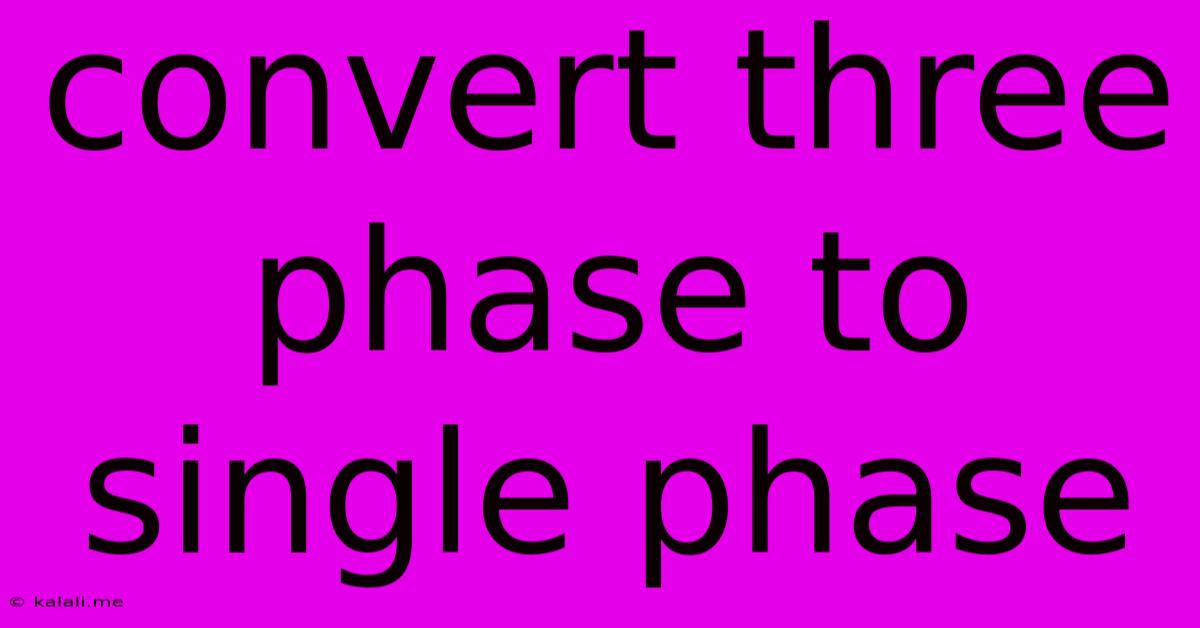Convert Three Phase To Single Phase
Kalali
May 20, 2025 · 4 min read

Table of Contents
Converting Three-Phase Power to Single-Phase: A Comprehensive Guide
Converting three-phase power to single-phase is a common requirement in many industrial and residential settings. Whether you need to power a single-phase appliance in a three-phase environment or are working on a smaller project requiring less power, understanding the methods and considerations is crucial. This guide will explore various techniques for this conversion, focusing on safety and efficiency. Choosing the right method depends heavily on the power demands and the existing three-phase system.
Why Convert Three-Phase to Single-Phase?
Many industrial facilities and some larger homes operate on three-phase power, offering higher voltage and power capacity. However, many common appliances and tools, such as lighting, smaller motors, and household electronics, operate on single-phase power. The need to convert arises when these single-phase devices need to be used in a three-phase environment. This conversion is also necessary for smaller projects or workshops which may not require the full capacity of a three-phase system.
Methods for Three-Phase to Single-Phase Conversion
Several methods exist for converting three-phase power to single-phase. The most common include:
1. Using a Single-Phase Transformer:
This is perhaps the simplest and most common method. A transformer designed for three-phase to single-phase conversion takes one of the three phases and a neutral (or sometimes even just one of the three phases without a neutral) and steps it down to the required single-phase voltage. This is ideal for smaller loads and is relatively inexpensive. However, it only utilizes one of the three phases, potentially wasting power. Careful selection of the transformer's rating is essential to prevent overloading and ensure safe operation.
2. Scott-T Transformer Connection:
This method uses two transformers connected in a specific configuration to produce a balanced single-phase output from a three-phase input. It offers a more efficient utilization of the three-phase power compared to simply using a single phase from the supply. The Scott-T connection is more complex to implement but provides a more balanced and efficient single-phase power source. It's often preferred for higher power applications.
3. Using a Rotary Converter:
Rotary converters are electromechanical devices that convert AC power from one frequency and voltage to another. They can be used to convert three-phase AC to single-phase AC, although they're less common now due to higher maintenance and cost compared to transformer-based solutions. They offer smooth, high-quality conversion, but their size and complexity make them less practical for most applications.
4. Using a Variable Frequency Drive (VFD):
While primarily used for motor control, a VFD can also be configured to output single-phase power from a three-phase input. This is a more advanced method that allows for precise control over voltage and frequency, but it's more expensive and requires specialized knowledge. VFDs are often used in applications requiring specific voltage and frequency control.
Safety Considerations and Best Practices
- Always work with qualified electricians: Three-phase power is dangerous and working with it requires expertise. Improper wiring can lead to serious injury or equipment damage.
- Use appropriately rated equipment: All transformers, converters, and wiring must be rated for the appropriate voltage and current.
- Proper grounding: Ensure the system is properly grounded to prevent electrical shocks and equipment damage.
- Regular inspections: Periodically inspect the conversion equipment for any signs of damage or wear.
- Overload protection: Use circuit breakers or fuses to protect the equipment and wiring from overload.
Choosing the Right Method
The best method for converting three-phase to single-phase depends on several factors, including:
- Power requirements: The amount of power needed by the single-phase load will determine the size and type of converter required.
- Budget: Transformers are generally the most cost-effective option, while rotary converters and VFDs are more expensive.
- Efficiency: Scott-T transformers offer better efficiency than simply tapping off one phase.
- Complexity: The complexity of the installation will influence the choice of method.
By carefully considering these factors and seeking professional assistance when necessary, you can safely and effectively convert three-phase power to single-phase for your specific needs. Remember safety is paramount; always prioritize safety procedures and seek professional help when in doubt.
Latest Posts
Latest Posts
-
How Does Brita Filter Sensor Work
May 21, 2025
-
No Video Supported Format And Mime Type Found
May 21, 2025
-
Can A Rabbi Marry A Non Jew
May 21, 2025
-
Do You Integrate Acceleration To Get Velocity
May 21, 2025
-
Minimum Soil Depth For Grass Over Concrete
May 21, 2025
Related Post
Thank you for visiting our website which covers about Convert Three Phase To Single Phase . We hope the information provided has been useful to you. Feel free to contact us if you have any questions or need further assistance. See you next time and don't miss to bookmark.